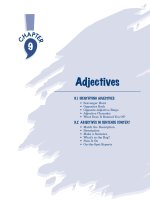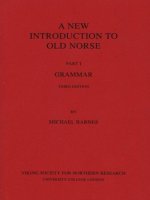UEfAP grammar introduction adjectives
Bạn đang xem bản rút gọn của tài liệu. Xem và tải ngay bản đầy đủ của tài liệu tại đây (111.91 KB, 2 trang )
25/2/2016
UEfAP Grammar: Introduction Adjectives
UEfAP Grammar: Introduction Adjectives
Grammar in EAP
Adjectives & Adjectival Groups
Adjectives are words such as “beautiful”, “ugly”, “new” or “old”. They usually denote qualities or
have a descriptive meaning. The most typical position for an adjective is between a determiner and
a noun. Typical forms of adjective endings are: “able/ible”, “ish/like”, “ful/less”, “ous” or “y”.
Adjectives may display inflection for degree: “er” & “est”. They have two main functions: as
modifiers of nouns in nominal groups, and as head of an adjectival group.
An adjectival group is typically a group with an adjective as its Head. That adjective is likely to be
modified either before the adjective (premodification) or after the adjective (postmodification or
qualification) or both. Premodifier are always adverbs "e.g. extremely, rather, too, very". Post
modifiers are often adverbs, prepositional phrases or certain types of clause. For example, in the
adjectival group “very difficult indeed”, “difficult” is an adjective in the head position. It is premodified
by “very” and postmodified or qualified by “indeed”.
Adjectives and adjectival groups are commonly used in academic texts (Biber, Johansson, Leech,
Conrad & Finegan, 1999, p. 506).
Exercise
Try this exercise in identifying adjectives: Grammar: Adjectives Exercise
Adjectives or adjectival groups can be used either attributively (e.g. the big house) or predicatively/as
complements (e.g. the house is big)
Adjectival groups are commonly used attributively as pre or postmodifiers of nouns in nominal
groups.
For example:
as premodifier the constitutional aspects
as postmodifier – varieties common in India, the festival proper, something different
See: Attributive adjectives: Grammar: Attributive Adjectives
Complex adjectival groups used as complements are common in academic writing.
See: Adjectival groups as complements: Grammar: Adjectival Groups as Complements
Exercise
/>
1/2
25/2/2016
UEfAP Grammar: Introduction Adjectives
Adverb
Typical adverbs are words such as "hopefully" or "recently". However, other words, such as "now",
"then", "always", "often" are also classified as adverbs. Many adverbs have the "ly" ending.
There are three main positions for adverbs: before the subject of the sentence, between
the subject and the predicator, at the end of theclause.
Traditionally adverbs are divided into 5 main categories: 1. circumstantial adverbs (of time, place,
manner etc) ("tomorrow, then, sooner, later, ..., here, there, outside, down, through, near, far, ...,
carefully, quietly, academically, ..."), 2. stance adverbs ("certainly, apparently, wisely, hopefully,
thankfully, ...") , 3. degree adverbs ("most, least, ...quietly, fairly, roughly, more or less, enough, too,
...", 4. focussing adverbs "just, hardly, only, even, ..."), 5. connective adverbs ("first, furthermore,
altogether, otherwise, or rather, ...".
Adverbs are relatively common in academic texts. According to Biber, Johansson, Leech, Conrad &
Finegan, (1999, p. 65), approximately 10% of lexical words in academic texts are adverbs, 55% are
nouns, 20% are adjectives, and 15% are verbs.
Adverbial Group
An adverbial group is typically a group with an adverb as its head. That adverb is likely to
be modified either before the adverb (premodification) or after the adverb (post
modification or qualification) or both. For example, in the adjverbial group "more fluently than
before", "fluently" is an adverb in the head position. It is premodified by "more" and post
modified or qualified by "than before".
Exercise
Adjectives and adverbs are often confused: See Adjective/Adverbs: Grammar: Adjective/Adverb
/>
2/2









